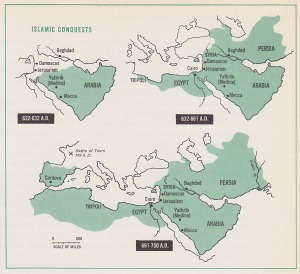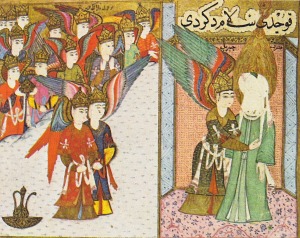When the Muslim prophet, Muhammad, died in June 632 A.D., Abdullah ibn Abi Qahafa (Abu Bakr) was appointed his political and military successor. Abu Bakr immediately launched a campaign of marauding conquest and colonization. He set in motion the most vigorous military expedition since Roman times.

Conquests of the Religion of Peace
Abu Bakr’s reign was short lived. He died on 23 August 644, but was succeeded by Umar ibn al-Khattab who continued his own systematic conquest and wars. Under Umar, the Islamic empire grew at an increased rate. He attacked Syria, Persia, Egypt, and every patch of ground in between. His armies looted town after town along the way [i]. It was a pirate strategy [ii]. He annexed them all under Islamic control. According to one estimate Umar had captured over 4,000 cities [iii], though this seems highly exaggerated. Ten years after becoming the supreme commander of the Islamic armies, Umar lay dead. His assassination was carried out by a Persian slave in retaliation to the conquest of their homeland [iv].
Uthman ibn Affan became the fourth Muslim warmonger. Although Uthman was considered a weakling by some standards, he expanded military campaigns westward, invading territories at a faster pace than his predecessor. Much of Christendom was obliterated in the span of a few years by his desolating and all-absorbing conquests. He crushed the Christian defenses in Palestine, Armenia, Afghanistan, Pakistan, Iran, and pushed as far west as Morocco. He built a fort on Cyprus from which he staged attacks on Crete and other islands off the coast of Turkey. He raided southern Egypt in 652. In 654 Uthman ordered a daring strike on the eastern Christian capital Constantinople. Just before the attack was launched Uthman was murdered.

Muhammad's Night Journey to Jerusalem
It was the city of Jerusalem the Islamic invaders wanted most. The Muslims reckoned it was rightfully theirs; after all, their prophet had a “night journey” there. From roughly September 634 A.D. to August 636, Muslims ravaged the Christian lands in Syria and Palestine. This marked the first wave of Islamic conquests into biblical lands.
After ravaging Yarmouk in July 636, Khalid ibn al-Walid, the so-called “Sword of Allah [v],” commanded his armies south toward Jerusalem. By this time, the Muslim forces had been depleted or worn down. Fresh recruits were needed. Since volunteers were slow in coming forward, al-Marthanna ibn Haritha made speeches in the mosques calling for assistance. Marthanna described the immense plunder obtainable by those who followed the call of Allah and for those who would fight against the Christian “polytheists.” His sermon speedily mobilized Iraqis and some Persians who had become recent converts to Islam. Sensing that the political winds were permanently blowing toward Mecca instead of Constantinople, the stirring appeal worked. They conciliated and obeyed their new, and now undisputed Muslim masters. They went to the Syrian front in search of rewards and riches and treasure – all sanctioned by Allah of course.

Just another "bloodless" battle
Unable to compete with the vastly superior and more numerous Byzantine army, the Muslims harassed the surrounding countryside. By cutting off Jerusalem’s supplies, they took the city by starving the inhabitants. The primary Muslim siege against the Holy City lasted four months; it eventually capitulated in 637. Sophronius, the Patriarch of Jerusalem, opened negotiations with Khalid ibn al-Walid and an agreement was reached on terms of surrender. Muslims boast to this day that it was “bloodless” victory.
In September of that same year, 637, initial terms and conditions were drawn up near Deraa, now the southern border Syria with Jordan; notably, the very place of battle between Israel and Og, King of Bashan [vi]. The Muslim commanders were dressed in rich robes, their war horses fitted with the spoils of battle. The Muslim warlords were later rebuked for their pompous indignation by Umar himself who had recently arrived to secure the Jerusalem hand-off [vii]. Later, as Umar toured the Church of the Sepulchre, Sophronius whispered in Greek to one of his subordinates, “Surely this is the abomination of desolation standing in the holy place spoken of by Daniel the Prophet [viii].” Sophronius would later write that the Muslim invaders were “unwitting chastisement of the weak and wavering Christian community” which had fallen astray from the faith; the loss of the city to Muslim infidels was in the Patriarch’s view divine judgment on God’s own people [ix]. They had become negligent in their faith and therefore God had sent the Muslim heathen to punish them.
Even before Emperor Constantine’s conversion (circa 313 A.D.) the Christians had built churches throughout the Holy Land. For reasons unknown the Christians refused to build anything on the Holy Temple site. Umar immediately saw this as an opportunity. He confiscated the empty lot and erected a mosque which, in its various forms and additions, has now become the Dome of the Rock [x].

Built as a "determination to assert the primacy of Islam throughout the Holy Land"
The Arab conquerors offered their new subjects an opportunity to convert to Islam. Those who refused were forced to pay tribute to their new rulers. This tribute, called jizyah, is a specific tax for non-Muslims who lived in “Muslim” territories. In return for their money, the Christians were granted security for their lives, property, and their churches would not be destroyed. The Jews were not to live among them and inhabitants of Jerusalem would pledge their men in warding off future Byzantine armies if, by chance, Christendom wanted their country back [xi]. Christians were not allowed to build any new churches [xii] and the 12,000 Greeks and Romans living in the city were ordered to self-deport within three days [xiii].
Abandoned by the Byzantine garrison, the position of Christians living in the Holy Land was to deteriorate over the years. Most of the Christian tribes adopted Islam without further ado. In fact, the arrival of the Muslims was half-heartedly welcomed by a significant portion of the population. Many of the inhabitants were perceived by the orthodox church as heretics. Due to their theological ignorance they were only vaguely aware that their new rulers represented another religious faith. Furthermore, by professing Islam, they were able to join in as equals in an intoxicating life of military glory and plunder.
These raiding tactics worked well for Islam. Much plunder was rendered in the form of goods and taxes. Hence, Islam’s military expeditions were political and economical in nature. They were not for the sole purpose of forcing conversion to Islam as some purport. Dhimmi status was too profitable for this to have been the case [xiv].
Using Syria and Palestine as a base hordes of Muslim invaders swept into new lands. A push to Asia Minor became possible, as did raids and attacks against European cities. All these were brought into the ever widening circle of Islam.
[i] THE ARABS IN HISTORY, Bernard Lewis, page 53
[ii] THE GREAT ARAB CONQUESTS, John Bagot Glubb, page 123
[iii] MEDIEVAL ISLAMIC CIVILIZATION, Josef W. Meri & Jere L. Bacharach, page 844
[iv] THE ARABS IN HISTORY, Bernard Lewis, page 59
[v] FUTUH AL-SHAM, Hasan al Basri, page 8
[vi] Numbers 21:33
[vii] THE GREAT ARAB CONQUESTS, John Bagot Glubb, page 182
[viii] THE GREAT ARAB CONQUESTS, John Bagot Glubb, page 183 (quoting Daniel 9:27; Matthew 24:15); this quote also appears in Theophanes, page 339 Constantine Porphyrogenitus, “De administrando imperio”
[x] There are many conflicting stories about Umar’s mosque. There is one tale that alleges Umar refused to pray in the Christian churches for fear of setting a precedent. It is claimed that after he was gone, Muslims would take possession of the churches and convert them into mosques. This account has debunked by numerous historians, including many Muslims. History shows that Muslims have no reservation whatsoever of converting churches into mosques.
[xi] SHORTER ENCYCLOPDAEDIA OF ISLAM, H.A.R. Gibb & J.H. Kramers, page 270
[xii] DICTIONARY OF ISLAM. Thomas Patrick Hughes, page 228
[xiii] Ibid.
[xiv] THE OXFORD HISTORY OF ISLAM, John L. Esposito, page 312

Thank you, I’ve just been looking for info about this topic for a long time and yours is the best I have found out so far.
LikeLike
Wrote an essay on the Siege of Jerusalem. Maybe you could let me know what you think about it. Thanks! Kevin
LikeLike
Outstanding! It’s well-written and painstakingly researched. Great job! Keep up the good work. I highly recommend this article to anyone wishing to learn more: http://spartachurch.wordpress.com/2011/12/15/siege-of-jerusalem/
LikeLike
Well done, Nichola. Loved reading this article.
LikeLike
Great story…
LikeLike
hello!,I really like your writing so much!
LikeLike
Hi Author, great story but I need to add some little statement..the word ” It was a pirate strategy [ii]” is not pretty suitable.. Saidina Umar is not a kind of devil.. He attacks and coincidentally expand the islamic territory because those Persian and Rome helping the enemy of muslim during war in the pass.. and thats why Umar fight back who helping islam enemy during that time. sharing is caring. 🙂
LikeLike
Isn’t it obvious no Islamic Mosque existed in the Christian Byzantine city of Jerusalem during Mohammad’s life? The story he visited the city by a flying horse is a dishonest attempt by Moslem’s to claim Jerusalem as their own. Arab forces didn’t seize Jerusalem until 637 A.D., five years after Mohammad’s death. The “alleged” Mosque was built decades later.
LikeLike